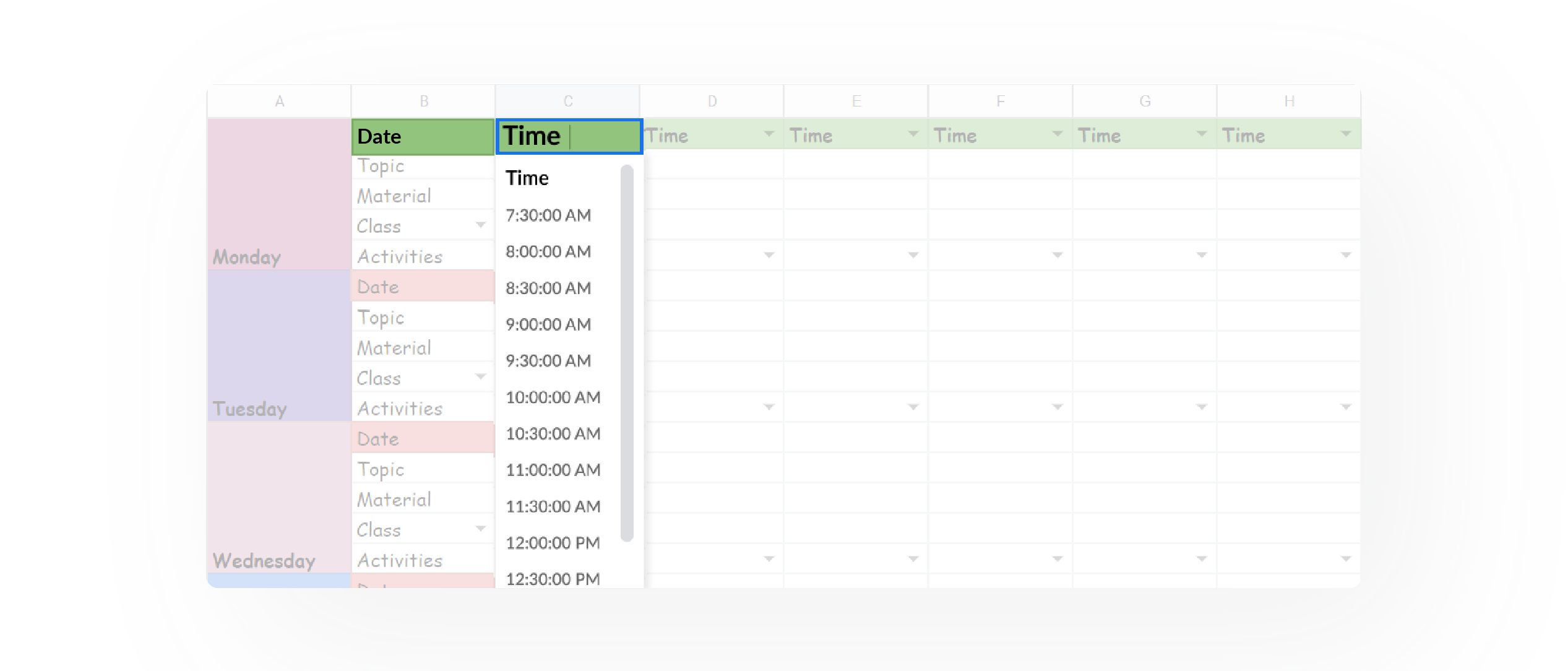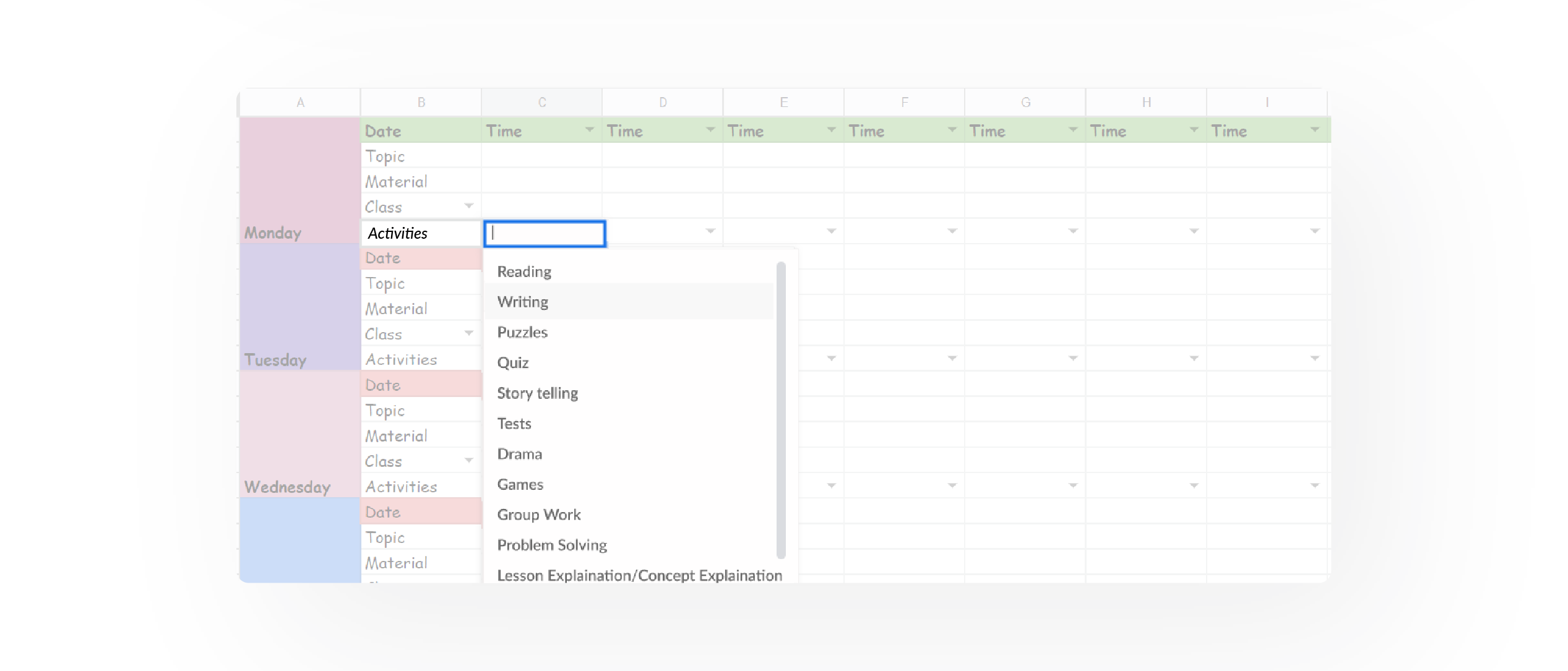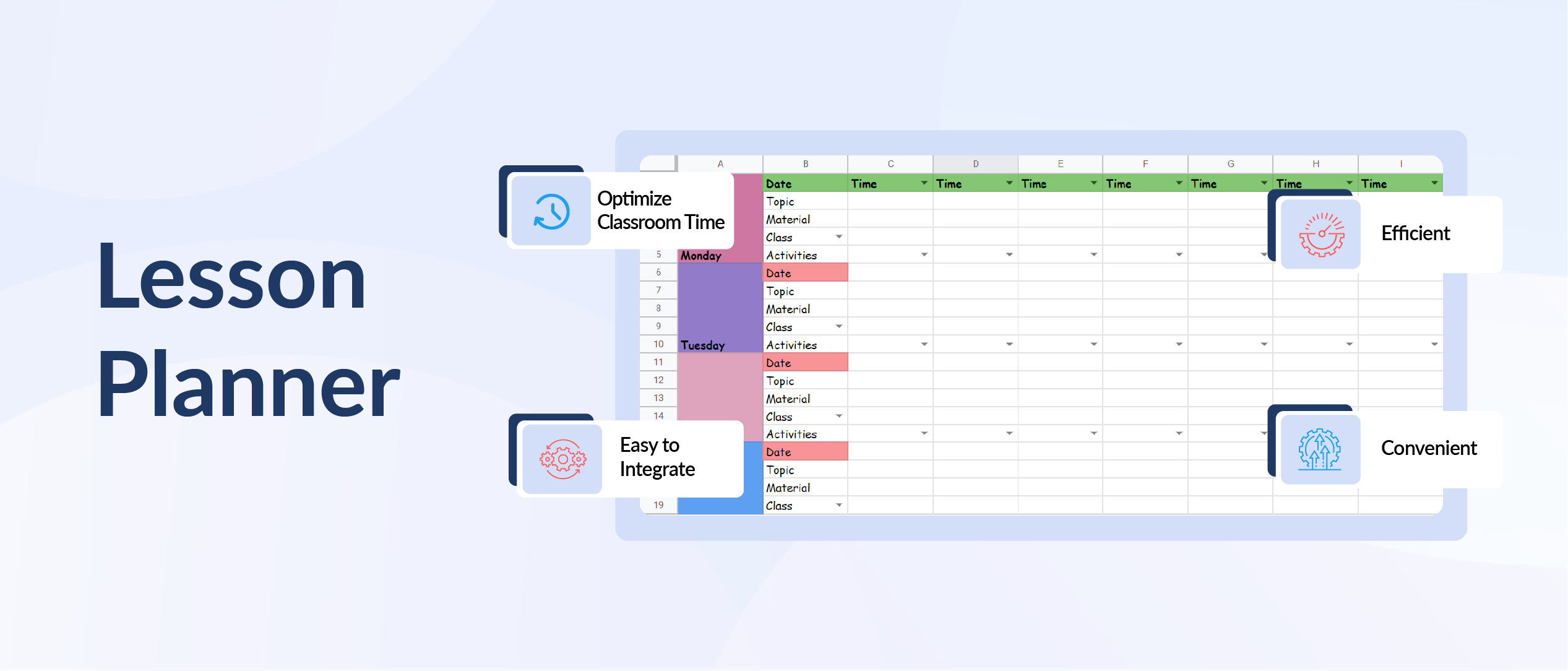- The preference of the teacher
- The subject being covered, and
- the needs of the students
For every teacher, the primary aim is to teach effectively and to ensure that the learning process is efficient. For this, the students have to be engaged and motivated.
An engaging lesson starts with an engaging lesson plan. A lesson plan will help teachers to engage with students in a better way. It also helps in removing chaos and confusion and to stay on schedule.
There may also be requirements that are mandated by the school system with respect to the plan. It is the teacher's guide for running a particular lesson and includes:
- What the students are supposed to learn, i.e. the goal
- How the goal will be reached i.e. the method or procedure to be followed in the lesson, and
- A way to measure how well the goal was reached is with the help of tests, worksheets, homework assignments, etc.
How a Lesson Planner Can Benefit Teachers
Creating a lesson plan is much easier if the teacher has access to a lesson plan template in a proper lesson plan format. Teachmint is offering free lesson plan templates for teachers to make the process of lesson planning efficient and instant. However, this raises quite a valid question - how would teachers benefit from a lesson plan creator, complete with a proper lesson plan format and lesson plan template free of cost? Here are a few advantages of using our free lesson plan template:
- Convenience
This is one of the most motivating factors to consider using a teacher with a proper lesson plan format - it can make the process seamless and smooth without having to put a lot of thought into creating it manually from scratch.
- Saves Time
By using templates, teachers can cut down greatly on the amount of time they spend working on the lesson plan, hence giving them time to focus on preparing for the class they have to take instead. This can have seriously positive implications in the long term.
- Introduces New Teachers to Lesson Plans
Teachers who are unfamiliar with the concept of lesson plans or are relatively new to the field of teaching can find it difficult to create such a detailed plan from scratch. This is where a lesson plan template can help - it can help organize their lessons systematically and spread them out evenly over the desired period of time without having to tediously sort them out at each stage.
- Easy to Integrate Into Virtual Learning Environment
Since most classes today are increasingly being conducted online, it is only fair that every aspect of education follows that trend for a smoother seamless transition. As a part of this, students can use a digital lesson plan creator to make the most of online education and the digital space in general.
Why Teachers Need a Lesson Plan
Even though the concept of a daily lesson plan has been around for a long time, teachers are yet to use it at the scale at which they are supposed to be used, possibly because of their hesitation to make one from scratch. However, before getting into what a lesson plan template is and how it can help teachers, it is important to see why more teachers must use lesson plans more in their daily lessons than they do now. Given below are some well-thought-out reasons:
- Planning Improves Confidence
Most teachers would agree that taking a class is a responsibly tedious task and that it would be a boon to have tools that can help them assist in the same. A lesson plan can help teachers plan out their lessons beforehand, hence giving them an outline or skeleton of how the class should go forward. Having such a plan in place means that the teacher can focus on planning their lessons per section, hence improving their confidence.
- Optimize Classroom Time
A lot of teachers who don’t use lesson plans find it difficult to manage their average class time. Lesson planning can help teachers make efficient use of their time in the classroom, hence finishing the portions assigned to them on or before time which leaves the students with more time for co-curricular or extracurricular activities.
- Helps Substitute Teachers
Sometimes, when a teacher takes a long leave of absence, has a medical emergency, or abruptly resigns, substitute teachers fill in for them for the time being. Substitute teachers have to not only gel with the students in a way similar to the previous teacher but also pick up wherever the previous teacher left off, which can be quite difficult as it is. A lesson plan can make the latter process as smooth as possible.
- Self-Analyze Performance
A lesson plan is a visual representation of what the teacher had planned out in their head for the day, week, month, and/or year. So when they look back on it and the end of the expected timeframe, they can assess whether they have been able to successfully complete the lesson in the given time frame. If they could not, they can analyze their performance by retracing their steps and finding out what went wrong and where and on what day, hence making errors minimal.
- Promotes Lifelong Learning
Planning lessons in advance means that teachers need to also prepare in advance for their lessons. This encourages them to continue learning as a means of keeping in touch with their subjects. Lifelong learning is something teachers must invariably do to not only improve their knowledge of the subject but also equip themselves with all the answers for the possible out-of-syllabus questions that students might ask.
How to Create Your Own Lesson Plan
Now that the why is covered, it is time to look at how a lesson plan can be made. The process is described below:
- Determine Scope
First and foremost, decide whether you are creating a plan for the entire year, for a day, week, or just a single unit. This depends on a plethora of factors. Some teachers use weekly lesson plans to help students focus on the short-term objectives and tasks of a lesson, while others only use monthly plans to split the whole year evenly with respect to the lessons they have to teach. Weekly lesson plans are helpful in gathering regular feedback, and improving them as required with time. A detailed lesson plan for the entire course is an effective way of keeping students informed about the main objectives of the overall year and the topics going to be covered.
- Plan Tasks & Activities for the Lessons
After the scope of the lesson plan is decided upon, it is time to plan. To make the process easier, here are a few questions whose answers can help figure out the planning process. What will be your lesson in classes A, B, C, etc.? Are there any class activities planned?Are there any quizzes to be conducted? Is a test scheduled for the day? Make a list of such questions that are relevant to your everyday tasks and answer them one by one to get an idea about all the tasks and activities at hand.
- Make a List of Materials Required
Once all the tasks and activities are sorted out, it is time to check the inventory. If your lesson needs students to use or bring specific items such as notes, stationery, apps, books, or any other tools, ensure it is listed in the lesson plan. This will make sure that students do not forget important items when required. Recommended resources can also be indeed in this section, like websites, libraries, books, or anything else students can use to help improve their studies.
- Create a Timeline for the Lesson
Once all the lessons and activities are listed (preferably sorted in descending order of priority), make a timeline for the lesson. Allocate all the lessons for the day, week, month, or year into time slots, assigning a particular amount of time to each lesson. Make sure that this timeline is feasible and that you will be able to complete the tasks within said time.
- Leave Space for Notes & Feedback
After the lesson plan has been made, leave a small section for feedback and notes so that you can make notes of unanticipated changes in schedules and recommendations from the students as to how the teacher can improve the lesson plan.
How to Create a Lesson Plan Using the Lesson Plan Template?
A lesson plan template is effective only if you know how to create the lesson plan. Of course, it is easy to create a lesson plan with a free lesson plan template, but knowing the basics of the same is essential to make the whole process smooth and flawless. Let us take a look at how to make the lesson plan using the template:
Choose the Date and Time

Click on the drop-down button on the sheet to choose the time slot and fix the same. You can just add the date on the date column and based on the same, you can plan the lessons.
Choose the Class and Activity

Click on the drop-down button on the sheet to choose from the wide variety of classroom activities provided on the sheet. You will be able to find multiple options in the drop-down button and you can choose the activity that you want from these options.
Teachers can add other activities, add breaks, and special classes as per their requirements. The lesson plan template is easy to edit and share. If teachers want to make a different schedule, they can edit inputs as per their requirements.
How to Download the Lesson Plan Template?
- Click on Download The Lesson Plan Template Button
- Go to the “File” option on the top left
- Click on the “download” option
- Download the sheet
You now have access to the free lesson plan template and you can create your own lesson plans effortlessly. A well-defined lesson plan can help teachers ensure effective learning and it also eliminates chaos and confusion in addition to improving classroom efficiency.















